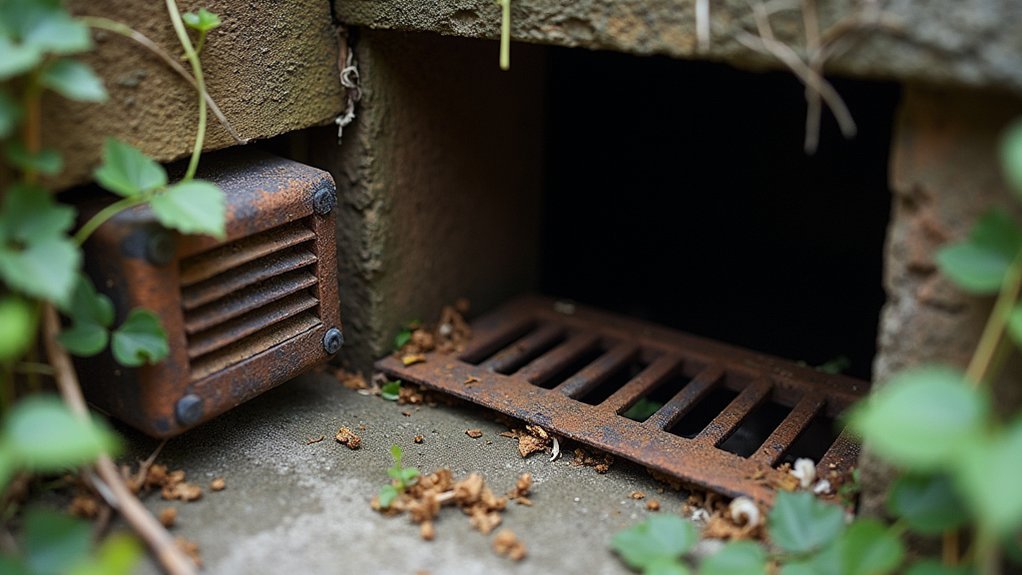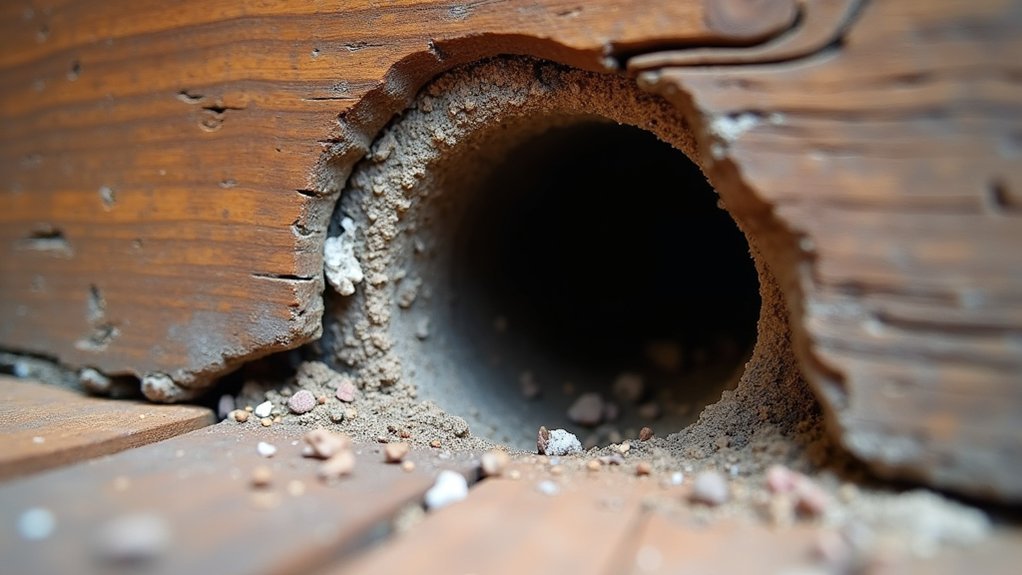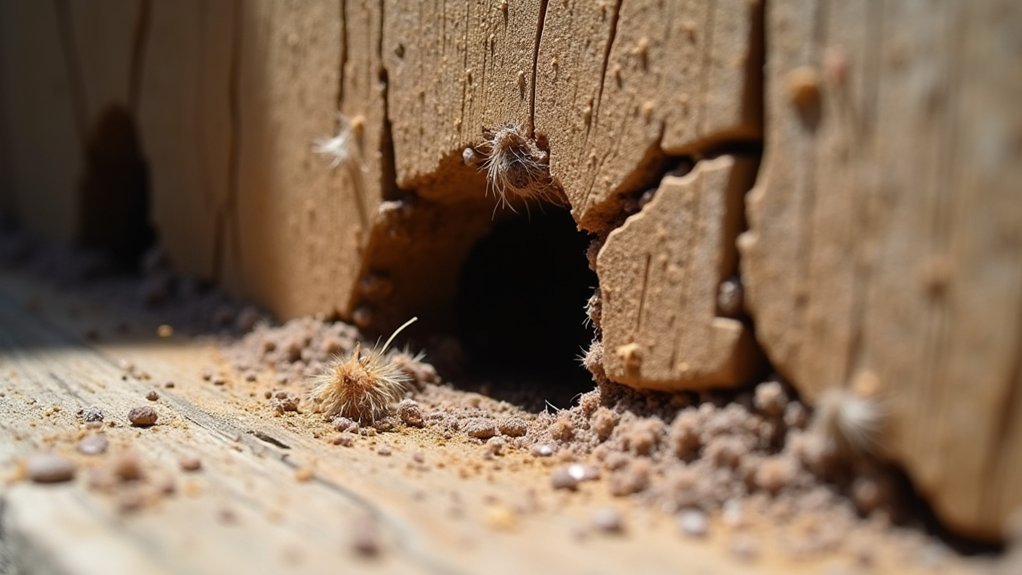To find rodent entry points, check your home’s exterior for cracks larger than ¼ inch in the foundation, gaps around doors and windows, and openings near utility lines. Inside, inspect kitchen areas, baseboards, and attics for droppings, grease marks, or gnaw marks. Use a flashlight to examine dark spaces and look behind appliances. Steel wool, caulk, and metal screens can effectively seal these vulnerabilities. The right inspection tools will reveal hidden access points you might otherwise miss.
Common Exterior Entry Points to Inspect

Five critical areas around your home’s exterior can become welcome mats for unwanted rodent guests.
Start by thoroughly examining your foundation and walls for cracks or gaps larger than 1/4 inch. These openings serve as primary entry points for rodents seeking food, water, and shelter.
Gaps in your foundation wider than a pencil eraser are essentially rodent highways into your home.
Don’t overlook the frames around doors and windows, where poor sealing creates easy access.
Inspect air vents and ducts, particularly older or damaged ones, as rodents can squeeze through surprisingly small openings.
Pay special attention to areas where utility lines enter your home—pipes, cables, and other penetrations can leave gaps as small as 15mm that rodents will exploit.
Finally, check your roofing and eaves, especially where vegetation touches your house, providing rodents a direct path to your home’s exterior.
Interior Vulnerabilities That Attract Rodents
Homes provide numerous internal hiding spots for determined rodents once they’ve breached your exterior defenses. To find rat entry points, inspect kitchen areas thoroughly, especially around cabinets, refrigerators, and stoves where food sources attract hungry pests.
Check for gaps around and under interior doors that might seem insignificant but serve as common entry points for mice. Don’t overlook cracks in walls and baseboards that rodents can enlarge to create pathways throughout your home.
Your attics and crawl spaces require special attention during rodent proofing efforts as they often contain hidden vulnerabilities.
Regularly monitor for signs of rodent activity including droppings, gnaw marks, and unusual scratching sounds. By identifying and addressing these interior vulnerabilities early, you’ll create a less hospitable environment and prevent infestations before they establish.
Signs Indicating Active Rodent Pathways

While rodents might seem elusive, they invariably leave telltale signs of their presence throughout your home.
Look for small droppings near entry points—mice typically produce 50-75 droppings daily, making this a reliable indicator of their pathways.
Examine walls and baseboards for grease marks where rodents frequently travel, leaving oily residue from their fur.
Inspect wooden structures, wires, and plastics for gnaw marks, which indicate active attempts to create or widen entry points.
Listen carefully at night for scratching or rustling sounds in walls and ceilings when rodents are most active.
You’ll also want to find any nests made from shredded materials in hidden areas like attics or behind appliances.
These signs, especially when found near food spills, confirm you’re dealing with established rodent pathways.
Essential Tools for Identifying Hidden Access Points
Detecting concealed rodent entry points requires specialized equipment that extends your observational capabilities beyond what the naked eye can see. When you inspect dark areas like attics and basements, a flashlight reveals where rodents may be traveling. For small holes behind appliances or furniture, use a mirror to check without moving heavy items.
| Tool | Primary Use | Entry Points Detected |
|---|---|---|
| Flashlight | Inspect dark areas | Shadowed corners, wall voids |
| Mirror | View concealed spaces | Behind fixtures, inside vents |
| Sticky traps | Track movement patterns | Active pathways, gaps and spaces |
A tape measure helps identify gaps larger than ¼ inch—plenty of room for mice to squeeze through. For thorough documentation of rodent problems, use your smartphone camera before contacting a professional pest control company.
Effective Sealing Methods for Various Entry Types

Once you’ve identified potential access points, sealing them properly becomes your critical next step in rodent-proofing your home.
Proper sealing of identified entry points is the foundation of effective rodent-proofing strategy for your property.
For holes larger than a quarter-inch, pack them tightly with steel wool or copper mesh, materials rodents struggle to chew through.
Apply quality caulk to seal cracks in walls and around windows, creating weatherproof barriers against rodent entry points.
Install weatherstripping on exterior doors to eliminate gaps that provide unwanted access.
Protect vents and ducts with metal screening, particularly in older buildings where original materials may have deteriorated.
Don’t overlook plumbing and electrical entries—these common weak points require special attention during your inspections.
Remember to regularly check the integrity of your sealing work, as determined rodents will exploit any developing weaknesses in your home’s defensive perimeter.
Frequently Asked Questions
How to Find Out Where Rodent Entry Points Are?
You’ll find rodent entry points by checking kitchen cabinets for droppings, inspecting foundation cracks, examining door gaps, looking for gnaw marks, and searching around vents, pipes, and areas with overgrown vegetation.
What Are the Most Common Entry Points for Rodents?
Rodents typically enter through gaps around pipes, cracks in foundations, unsealed vents, spaces under doors, damaged roof areas, and utility line openings. You’ll find they’re attracted to openings as small as a quarter-inch wide.
What Is the Open Field Test for Rodents?
The Open Field Test is a scientific assessment where you’ll observe rodents’ behavior in an unfamiliar arena to measure their anxiety and exploratory tendencies. It helps researchers understand how rodents respond to new environments.
How to Seal off Entry Points for Mice?
To seal off entry points for mice, you’ll need to apply weatherstripping under doors, caulk cracks in walls, stuff steel wool in holes around utility lines, and cover vents with metal screening. Regular inspections maintain effectiveness.
In Summary
Regularly checking your home for rodent entry points isn’t just about prevention—it’s about protection. You’ve now learned to identify both exterior and interior vulnerabilities, recognize active pathways, and use the right tools for detection. Don’t delay in sealing these openings with appropriate materials. Remember, a rodent-proof home requires ongoing vigilance and prompt action when you spot potential access points.





Leave a Reply